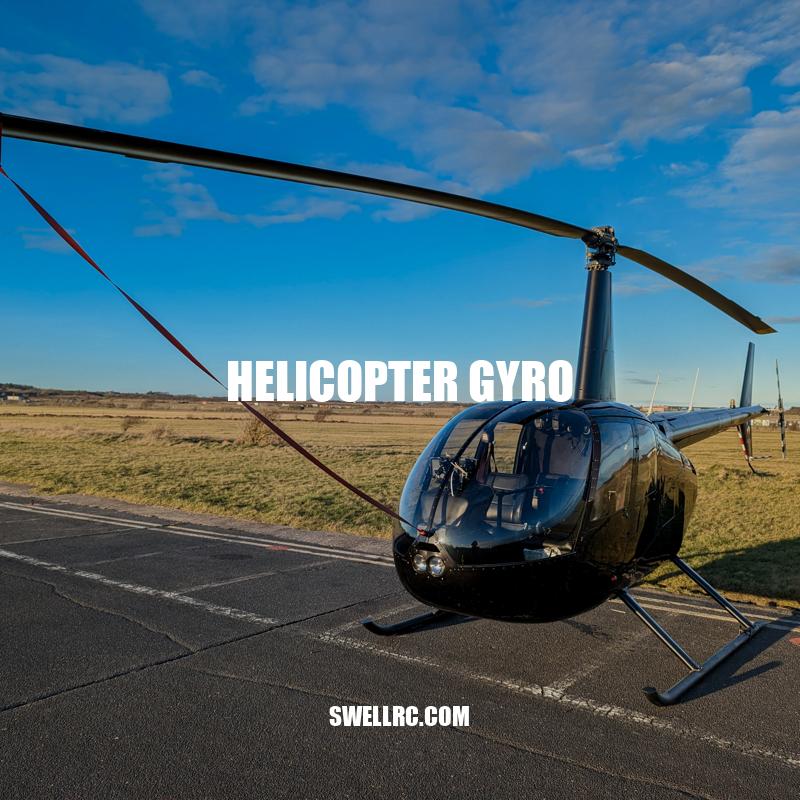Understanding the Helicopter Gyro: A Vital Component for Safe and Stable Flight
A helicopter is a complex aircraft that is capable of vertical takeoff and landing, hovering in mid-air, and flying forward, backward, and sideways. An essential component of this multilayered aircraft is the helicopter gyro, which plays a crucial role in stabilizing and controlling the helicopter during flight. A gyro, short for gyroscope, is a device that helps the pilot determine the orientation and balance of the aircraft. It maintains the helicopter’s level, keeps it from tipping over, and continues to provide directional stability in the presence of wind and turbulence. Without gyros, helicopters would be extremely difficult to control and susceptible to accidents. Over the years, advancements in gyro technology have helped revolutionize helicopter design and functionality, making them safer and more reliable than ever before. In this article, we’ll take a detailed look at helicopter gyros, their history, their importance in helicopter operation, and maintenance and repair tips to ensure safe and efficient flying.
A helicopter gyro is a device that helps control the stability and direction of the helicopter. It is a type of gyroscope that measures angular velocity, and its primary function is to maintain the helicopter’s orientation concerning its roll, pitch, and yaw axes. When a helicopter moves in any direction or encounters external disturbances like wind or turbulence, gyros provide a counteracting force to help the pilot maintain stability and control. There are two main types of gyros used in helicopters:
- Rate gyro: This gyro measures changes in rotational speed and helps determine the helicopter’s rate of turn about the yaw axis. It is usually located in the tail rotor system and helps maintain directional stability.
- Attitude gyro: Commonly known as the gyro horizon, this gyro measures changes in pitch and roll attitude of the helicopter. It provides the pilot with the critical information required to maintain the helicopter at a constant heading and altitude.
Helicopter gyros are essential for a safe and controlled flight, as they provide the pilot with the necessary navigational information to make informed decisions. Some gyros have digital displays that show vital aircraft parameters such as speed, altitude, and heading to the pilot. Websites like Aviation World provide in-depth information on helicopter gyros and their functions. New advancements in gyro technology have made them highly reliable, lightweight, and compact. To ensure maximum safety and avoid malfunctions, helicopter gyros need to be regularly maintained and inspected by certified professionals.
What is gyro used for?
Gyroscopes, or gyros for short, are used for stabilizing and maintaining orientation in various applications such as navigation, drones, spacecraft, and even in smartphones. They work by using the principle of conservation of angular momentum to detect changes in the orientation of the device. Some popular gyro products available in the market include the MPU-6050, L3GD20H, and ADXRS610, which are widely used in robotics and DIY projects. For additional information on gyros, you can check out websites such as Sparkfun or Adafruit, which offer a wide range of products and tutorials on gyros and other sensors.
Gyros play a crucial role in a helicopter’s operation by helping to maintain stability and ensure safety during flight. Below are some reasons why gyros are essential in helicopters:
- Provide Stability: Helicopters are inherently unstable aircraft, and a slight change in pitch or roll angle can cause the helicopter to spin out of control. Gyros provide a counteracting force to keep the helicopter stable and flying straight.
- Controls Piloting Task: A gyro provides pilots with critical information regarding the helicopter’s position and orientation, which helps them control the helicopter more effectively.
- Reduces Pilot Workload: Gyros reduce the workload of pilots by monitoring changes in the helicopter’s position and not requiring constant attention. This allows pilots to focus on other critical tasks such as navigation and communication.
- Prevents Overfatigue: Gyros keep the helicopter in a constant position, and they prevent pilots from getting fatigued when they need to compensate for changes in orientation constantly.
Helicopter gyros can malfunction, leading to disastrous consequences like loss of control or crashes. There have been notable incidents in the past, such as the crash of a Sikorsky S-76 helicopter in California, which was attributed to a broken tail rotor servo actuator. To avoid such accidents, safety protocols dictate that helicopters need to undergo pre-flight inspections before every flight, including analysis of gyro readings. A regular check-up with a certified gyro mechanic is recommended to ensure that the gyros remain in excellent working condition.
The importance of gyros in helicopters cannot be overemphasized. Websites like the Federal Aviation Administration provide guidelines and regulations on the maintenance and repair of gyro systems in helicopters. Regular checks and replacement of faulty gyros will ensure that helicopters maintain their stability and keep everyone on board safe.
Why is the gyro important?
Why is the gyro important?
Gyro, short for gyroscope, is an important device used in many applications to measure and maintain orientation. Here’s why it’s important:
– Gyros are widely used in aviation, navigation, and aerospace to measure the angular velocity of an object and maintain its stability and orientation.
– In military applications, gyros help guide missiles, torpedoes, and drones to their targets with great precision.
– Gyros are also used in everyday devices like smartphones and cameras to help stabilize images and videos, making them smoother and clearer.
Overall, gyros are crucial devices that enable many important technologies and applications.
If you’re interested in learning more about gyros and their applications, check out websites of manufacturers like Honeywell, Northrop Grumman, and Safran Electronics & Defense.
History of Helicopter Gyro
The gyro has been an integral part of helicopter design and functionality since the early days of rotary-wing aircraft. Below are some key developments in the history of gyro technology in helicopters:
- 1936: Anton Flettner, a German aviation engineer, installed a single-axis control gyro on the Flettner Fl 265 helicopter, which helped control yaw axis and reduce pilot workload.
- 1945: The Bell Aircraft Corporation developed the Bell Model 47 helicopter, the first rotorcraft with a stable and efficient helicopter gyro control system.
- 1953: Dr. August Raspet developed a dual-axis stabilization system using two gyroscopes, which allowed for single-handed control of a helicopter during testing.
- 1980s: The development of solid-state gyros and microprocessors led to more sophisticated and accurate gyro systems, improving the safety and performance of helicopters.
- Present: Today, gyros are an essential part of helicopter design and operation, and they continue to evolve with new technology advances.
Along with the development of gyro technology, many websites and resources help to educate pilots and mechanics on the use, care, and maintenance of gyro systems. The Helicopter Association International and Helicopter Safety Alliance are two examples of organizations that offer courses and training on gyro systems and safe helicopter operation. Access to these resources ensures that pilots and mechanics stay up-to-date with the latest developments in gyro technology and helicopter safety.
The helicopter gyro has come a long way since its inception, and continues to be an essential component in modern helicopter design. Its development has led to significant improvements in helicopter safety and performance, and its continued evolution promises to deliver even greater benefits in the future.
| Gyro Type | Description |
|---|---|
| Rate Gyro | Measures helicopter rotation rates and provides information for adjustments and stability. |
| Attitude Gyro | Monitors helicopter pitch and roll to ensure stable flight and provide necessary information to pilots. |
| Vertical Gyro | Provides information on helicopter vertical motion for safety and altitude control. |
| Directional Gyro | Monitors helicopter heading and is vital for navigation. |
Are gyroscopes used in helicopters?
Yes, gyroscopes are used in helicopters. Gyroscopes are utilized in the helicopter’s autopilot system to maintain the helicopter’s altitude and direction. They are also used to control the helicopter’s tail rotor and ensure stability during flight. Gyroscopes play a crucial role in safe helicopter flight.
For more information about the role of gyroscopes in helicopters, visit websites such as Flightglobal.com, Rotor.org, or Aerospacetech.com.
Maintenance and Repair of Helicopter Gyros
Proper maintenance and repair of helicopter gyros is necessary to ensure the safety and proper functioning of these vital components. Below are some key points to consider:
- Regular maintenance of gyros is key to identifying problems early and preventing major issues from developing.
- Gyros should be cleaned on a regular basis, following the manufacturer’s recommended procedures.
- It is important to replace gyro components that show signs of wear and tear, such as bearings, gears, and rotors.
- Pre-flight inspections of the gyro system are essential before every flight to ensure that all components are secure, all connectors are plugged in, and there are no signs of damage or malfunction.
- If a gyro system fails or starts to malfunction, it is essential to seek repair services from qualified technicians who understand the unique needs of helicopter gyro systems.
To maintain and repair helicopter gyros, certified helicopter maintenance technicians must have the proper skills and training. Many training programs, courses, and workshops are available to ensure that technicians have the expertise and knowledge needed to properly maintain and repair gyro systems. These resources include:
- The Helicopter Maintenance Magazine, which provides in-depth articles and tutorials on maintaining and repairing helicopter systems, including gyros.
- The Helicopter Association International, which offers courses and workshops for helicopter maintenance technicians on gyro system maintenance and repair.
- Specialized gyro manufacturers and repair shops, which are trained in repairing and servicing gyro systems according to manufacturer guidelines.
By utilizing the available resources and ensuring that maintenance and repair work is performed by qualified professionals, helicopter operators can ensure that their gyro systems are functioning properly and their aircraft are safe to fly.
What is gyro on a helicopter?
A gyro on a helicopter refers to the gyroscope, a mechanical device that helps the pilot maintain orientation and stability of the aircraft. The gyroscope senses any changes in the aircraft’s pitch, yaw, and roll and provides feedback to the helicopter’s control system. This technology helps keep the helicopter stable in flight and is a crucial component in modern helicopter design.
For more information on helicopter technology, visit websites such as Helicopter Association International or the Federal Aviation Administration. Alternatively, check out helicopter models from manufacturers such as Airbus, Bell, or Robinson for a closer look at how gyroscopes are integrated into their designs.
| Websites | Products |
|---|---|
| Helicopter Association International | – |
| Federal Aviation Administration | – |
| – | Airbus Helicopters |
| – | Bell Helicopter |
| – | Robinson Helicopter Company |
Conclusion
In conclusion, the helicopter gyro is a crucial component in ensuring the safe and efficient operation of helicopters. Its role in providing stability, balance, and control of the aircraft cannot be overstated. Proper maintenance and repair of gyros is essential to avoid mechanical failures and prevent accidents.
Being aware of the functions and importance of a gyro can provide a better understanding of the workings of a helicopter. It also highlights the need for regular inspection and maintenance.
In recent years, advancement in gyro technology has resulted in more precise and reliable systems that contribute to a safer and more efficient helicopter operation. It is crucial to stay up-to-date with these advancements to ensure that gyro systems are operationally efficient.
In conclusion, the gyro system is an essential component of the helicopter’s flying system. Any malfunction can be disastrous. Hence it should be adequately maintained, regularly inspected, and serviced by qualified professionals. The successful functioning of the system ensures both the safety of the aircraft and the crew.



